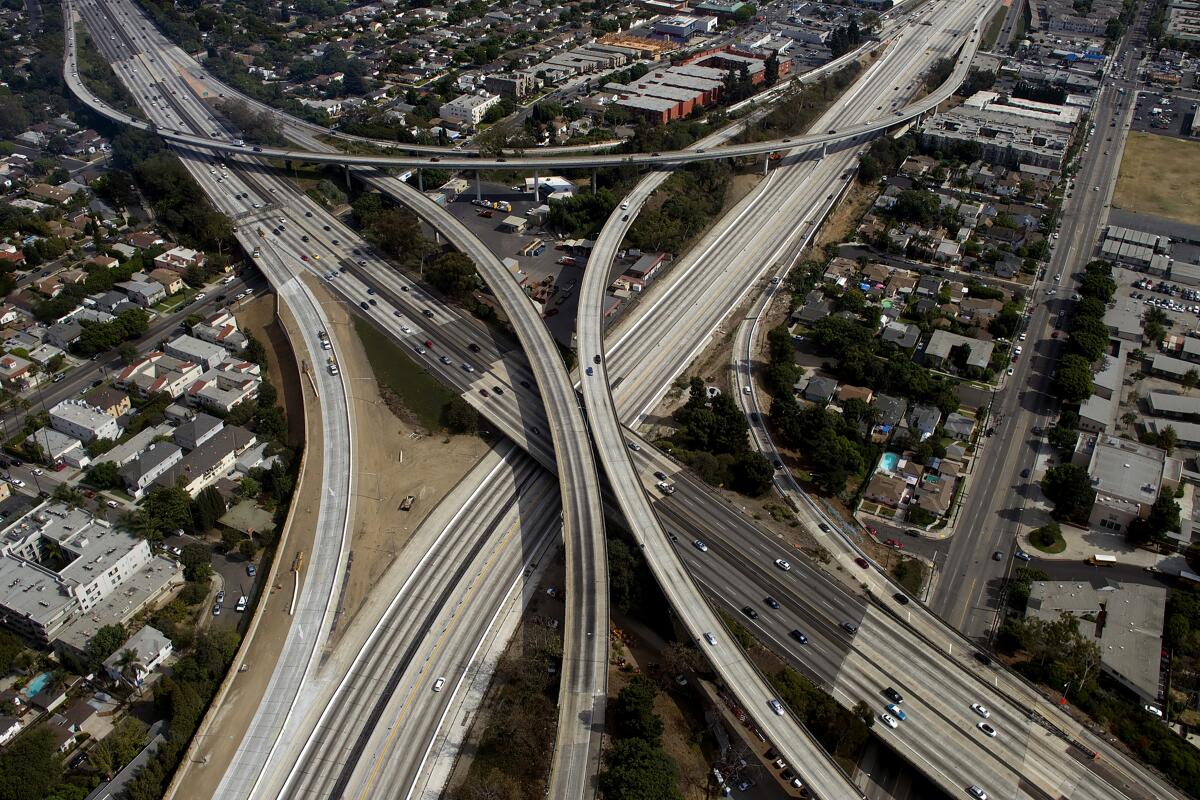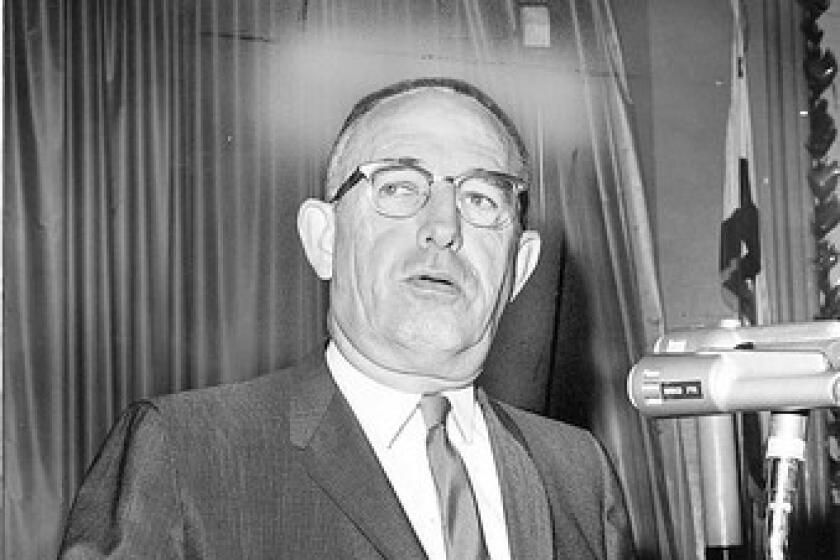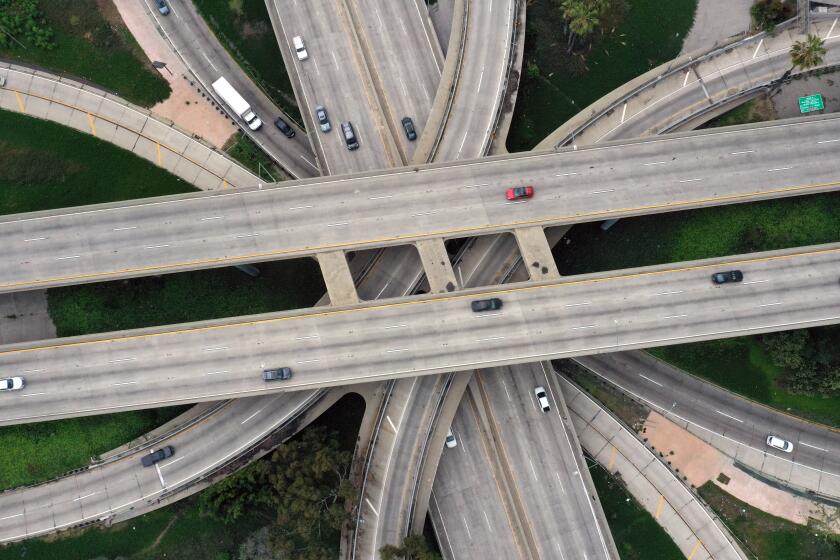Want to tear down insidious monuments to racism and segregation? Bulldoze L.A. freeways

- Share via
Across the country, Confederate monuments are tumbling. Museums are stripping effigies of racist presidents past. Here in Los Angeles, indigenous activists toppled a statue of Junipero Serra, a canonized saint who founded the mission system that enslaved and brutalized generations of California Indians into abandoning their traditions.
The aftermath of George Floyd’s death while in police custody has created a moment for radical truth-telling. So here’s some ugly truth about the city of Los Angeles: Our freeway system is one of the most noxious monuments to racism and segregation in the country.
Most Angelenos don’t think about it as we spew carbon monoxide across the city on our way from Point A to Point B, but our toxic exhaust fumes feed into a pot of racism that’s been stewing for nearly a century. To understand exactly how that works, you have to know what things were like here before freeways came to dominate L.A.’s landscape.
Police brutality didn’t just spring from the minds of racist police. It reflected the will of white people to segregate. In many ways it still does.
Los Angeles was never a paradise of racial acceptance, but in 1910 some 36% of L.A.’s African Americans were homeowners (compared with 2.4% in New York City) — tops in the nation. L.A.’s comprehensive Red Car transit system, which offered easy, unsegregated access to the region’s growing economic opportunities, was fundamental to this success. Integrated, racially diverse neighborhoods like Watts and Boyle Heights emerged and thrived along these transit corridors.
But as L.A.’s population surged from 320,000 in 1910 to more than 1.2 million in 1930 — including tens of thousands of African Americans from the Deep South — white Los Angeles decided it was time to ramp up its own brand of Jim Crow segregation.
These efforts took many forms — most famously racially restrictive covenants, which barred African Americans and other ethnic minorities by deed from living in houses and neighborhoods deemed “white.” Where covenants failed to keep the races separate and unequal, rising Ku Klux Klan violence targeted African American families who attempted to integrate. Bombings, cross burnings and even drive-by shootings were largely successful in keeping people of color out of “white” communities like Eagle Rock in northeast Los Angeles. Then there was Manhattan Beach, which seized the homes of every African American property owner in town by eminent domain and razed them. The city then turned the land into a whites-only park.
But neither the Klan nor legally dubious covenants nor flagrantly unconstitutional land grabs were arguably as effective as the automobile and its attendant infrastructure at turning Los Angeles into an intentionally segregated city.
When the 1944 Federal-Aid Highway Act allocated funds for 1,938 miles of freeways in California, planners used the opportunity, with full federal support, to obliterate as much as possible the casual mingling of the races.
Local officials rerouted the elaborate designs of freeway engineers — often at considerable expense — to destroy thousands of homes in racially diverse communities. As detailed by Gilbert Estrada in “If You Build It, They Will Move,” mixed-race Boyle Heights was gutted by freeways. Despite a mandate to avoid parks at all costs, planners put lanes through the middle of Hollenbeck Park while spending millions to reroute around a park in the white suburb of San Dimas. Dozens of Boyle Heights homes were destroyed just to give white suburban shoppers easier freeway access to a Sears department store.
There is no herd immunity from the damage caused by millions of personal automobiles roaming city streets at all hours.
Officials justified these actions as “slum clearance”— intended to upgrade the city’s supposedly crumbling housing stock. But their racially malign intent was obvious, laid bare when officials moved the Santa Monica Freeway so that it ran directly through the stately African American middle class neighborhood of Sugar Hill — anything but a slum — wiping it off the map.
When L.A. communities of color rose up in protest at the destruction of these neighborhoods, they were ignored. White areas like Beverly Hills and South Pasadena, meanwhile, successfully fought off freeways planned through their neighborhoods. As noted by Estrada, only 61% of L.A.’s planned freeway network was built as a consequence. This created immediate traffic bottlenecks in the system, which have lingered to this day.
Much of this freeway construction was in service of a suburban housing boom that was explicitly segregationist.
As freeways enabled L.A.’s car-dependent suburbs to expand outward, they did so under the guidance of federal and local policies explicitly designed to keep those neighborhoods white-only. As historian Richard Rothstein detailed in his book “Color of Law,” developers who secured generous federal financial assistance were barred from building racially integrated housing by the Jim Crow federal lending policies of the day. Of the 125,000 Federal Housing Authority units built in Los Angeles County between 1950 and 1954, less than 3% of those were open to people of color.
Freeways created physical barriers that made any non-white presence on the “white” side of the road conspicuous — and thus easier to target by law enforcement. One 1943 freeway marketing pamphlet, designed to win over reluctant white communities, boasted of the freeway’s fortress-like impermeability and ability to preserve “neighborhood character.”
As Rothstein told NPR in 2017: “The ‘Underwriting Manual’ of the Federal Housing Administration recommended that highways be a good way to separate African American from white neighborhoods. This ... was a matter of government regulation.”
Blocked from moving to L.A.’s pristine new suburbs, non-white freeway evictees and newly arrived Black migrants from the Jim Crow South were forced to find housing in the already overcrowded, segregated areas of South and East Los Angeles, away from established and emerging job centers — and in the middle of freeway pollution corridors.
Those segregated housing patterns have largely persisted to this day.
By the mid-1950s, freeway traffic was already generating unhealthy smog that began to choke the city. Facing public outrage, L.A. transit planners drew up designs for a high-speed monorail system to ease congestion along the city’s busiest corridors, including areas that would have served African American communities in South Los Angeles.
Even greater public outrage ensued. The plan never got off the ground.
Decades later, the effects of these decisions are not felt equally. Poor communities of color continue to suffer most from the legacy of segregation and racially motivated freeway construction through their neighborhoods. The health outcomes in these areas are bleak. Pollution kills. Children directly exposed to freeway pollution have higher rates of asthma and unnatural cognitive decline. Segregation endures.
Los Angeles is not unique in this regard. Cities across the country made similar choices. And yet nowhere have the consequences been felt more profoundly.
Decades of activism still haven’t overwhelmingly convinced white Americans that monuments to the Confederacy are intolerably racist. Remedying the enduring effects of white supremacy will be far more challenging — in progressive Los Angeles as much as in Alabama or Mississippi. And it will be impossible if we aren’t honest about the history that made things the way they are —and the massive undertaking it will require to rectify them.
Something to think about the next time you’re complaining about traffic on the 10.
More to Read
A cure for the common opinion
Get thought-provoking perspectives with our weekly newsletter.
You may occasionally receive promotional content from the Los Angeles Times.









